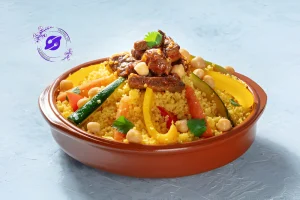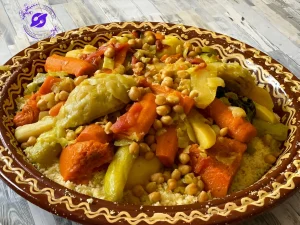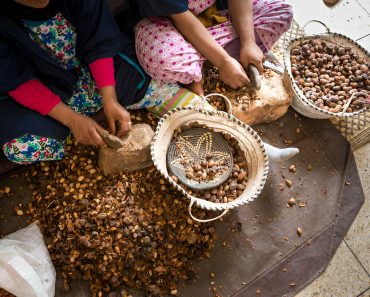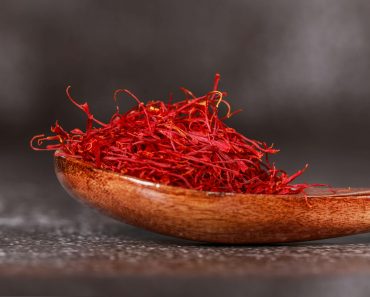
Moroccan Couscous
In the vibrant tapestry of Moroccan cuisine, few dishes hold as much cultural significance and culinary allure as the iconic Moroccan couscous. This delectable dish, often hailed as a national treasure, is not just a meal but a symbol of hospitality, heritage, and the artistry of Moroccan cooking. As we delve into the history, ingredients, preparation, and unique characteristics of Moroccan couscous, we embark on a flavorful journey through time and tradition.
A Brief History of Moroccan Couscous
The origins of couscous can be traced back to ancient Berber cultures, where it was prepared as a nourishing staple food. Over centuries, this humble grain dish evolved into the cherished couscous we know today. Moroccan cuisine, renowned for its rich flavors and diverse influences, embraced couscous as a cornerstone of its culinary identity.
Historically, couscous was prepared by hand, a labor-intensive process that involved rolling and shaping semolina wheat into tiny granules. This traditional method, while time-consuming, imbued the couscous with a unique texture and character. With time, technological advancements streamlined the production of couscous, making it more accessible while preserving its essence.
The Place of Moroccan Couscous Culture
Moroccan couscous isn’t just a meal; it’s a cultural emblem woven into the fabric of everyday life. From family gatherings to festive celebrations, couscous takes center stage, symbolizing generosity, unity, and the joy of communal dining. In Moroccan homes, the ritual of preparing couscous is a cherished tradition passed down through generations, often accompanied by lively conversations and shared stories.
During special occasions such as weddings, religious holidays like Eid al-Fitr, or festive gatherings like Fridays, couscous becomes the pièce de résistance, prepared with love and served with pride. Its presence on the Moroccan table signifies abundance, hospitality, and the warmth of Moroccan hospitality extended to guests.
Characteristics of Moroccan Couscous
What sets Moroccan couscous apart is its delicate texture, aromatic flavors, and versatility in accompaniments. Unlike some other varieties of couscous, which may be finer or coarser, Moroccan couscous strikes a harmonious balance, offering a light yet satisfying mouthfeel. The couscous grains are fluffy, tender, and capable of absorbing the flavors of accompanying ingredients, creating a symphony of tastes in every bite.
The key to authentic Moroccan couscous lies not just in its preparation but also in the ingredients used. From fragrant spices to fresh vegetables, each element contributes to the dish’s complexity and depth. Traditional Moroccan couscous often features a medley of flavors, including sweet and savory notes that reflect the country’s diverse culinary influences.
Ingredients Used in Moroccan Couscous
- Semolina Wheat: The heart of Moroccan couscous, semolina wheat forms the base of the dish. Its fine texture, when steamed, results in fluffy, separate grains that define couscous.
- Spices: A blend of spices adds depth and aroma to Moroccan couscous. Common spices include cumin, coriander, cinnamon, turmeric, paprika, and saffron, each contributing its unique flavor profile.
- Vegetables: Moroccan couscous often includes a colorful array of vegetables such as carrots, onions, tomatoes, zucchini, and bell peppers. These vegetables are typically stewed or roasted before being combined with the couscous.
- Protein: While traditionally prepared with lamb or chicken, modern variations may feature beef, fish, or vegetarian options like chickpeas or lentils, offering diverse choices for different dietary preferences.
- Dried Fruits: A delightful addition to sweeten the dish, dried fruits like raisins, apricots, or dates are sometimes incorporated into Moroccan couscous, lending a hint of sweetness that contrasts with savory elements.
- Broth or Stock: To infuse the couscous with rich flavor, a flavorful broth or stock, often made with aromatic herbs and spices, is used during the steaming process.
- Harissa or Other Sauces: For those who enjoy a touch of heat and complexity, harissa, a North African chili paste, or other sauces may be served alongside Moroccan couscous, allowing diners to customize their spice level.
How to Cook Moroccan Couscous
While the traditional method of preparing couscous involved meticulous hand-rolling and steaming, modern kitchens have embraced convenience without compromising on taste. Here’s a simplified guide to cooking Moroccan couscous:
Ingredients:
- 2 cups couscous
- 2 ½ cups chicken or vegetable broth
- 2 tablespoons olive oil
- 1 onion, finely chopped
- 2 carrots, diced
- 1 zucchini, diced
- 1 red bell pepper, diced
- 1 teaspoon ground cumin
- 1 teaspoon ground coriander
- ½ teaspoon turmeric
- Salt and pepper to taste
- Fresh parsley or cilantro for garnish
Instructions:

Moroccan Couscous
- Prepare the Couscous: In a large bowl, pour the couscous and drizzle with 1 tablespoon of olive oil. Toss to coat evenly.
- Heat the Broth: In a pot, heat the broth until it simmers.
- Sauté Vegetables: In a separate pan, heat the remaining olive oil over medium heat. Sauté the onion until translucent, then add the carrots, zucchini, and bell pepper. Cook until slightly softened.
- Season and Combine: Add the ground cumin, coriander, turmeric, salt, and pepper to the sautéed vegetables. Stir to coat evenly.
- Steam the Couscous: Pour the hot broth over the couscous in the bowl. Cover tightly with a lid or foil and let it steam for about 10 minutes, allowing the couscous to absorb the liquid.
- Fluff and Serve: After steaming, fluff the couscous with a fork to separate the grains. Gently fold in the sautéed vegetables. Taste and adjust seasoning if needed.
- Garnish and Enjoy: Transfer the couscous to a serving platter, garnish with fresh parsley or cilantro, and serve hot alongside your choice of protein or sauce.
Conclusion: A Taste of Moroccan Tradition
In the realm of global gastronomy, Moroccan couscous stands as a testament to the enduring appeal of time-honored recipes and culinary craftsmanship. Its roots in history, depth of flavors, and symbolic importance in Moroccan culture make it not just a dish but an experience—one that invites us to savor tradition with every mouthful. Whether enjoyed in a bustling souk, a family gathering, or a cozy kitchen, Moroccan couscous offers a taste of heritage that transcends borders and celebrates the universal language of food.





